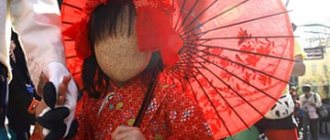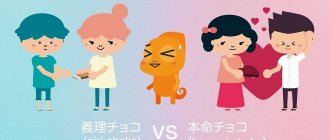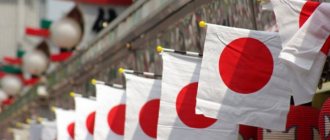The beginning of the City-Go-San holiday
When I went outside early in the morning, an amazing picture opened up in front of me:
Moms and dads, grandparents, along with little boys and girls, filled the entire space. Dressed in national kimonos, they were in a hurry somewhere. It was so beautiful! I didn’t even notice anything around: neither the crimson leaves of the maples nor the blooming chrysanthemums could take my eyes off the magnificent procession. I quickly ran after them.
Here's the stop. Everyone changes their shoes before entering the temple. The festival of childhood begins with a visit to the temple. Traditional rituals are performed here, different for each age group.
Holiday Traditions of City-Go-San November 15th
The traditions of the ancient Japanese said that children should walk with a shaved head until the age of three, which was shaved a week after birth. From the age of three it was allowed to grow hair. And at the age of five, a small man could wear hakama - special pants. Girls, who were girdled with an ordinary rope until the age of seven, celebrated their seventh birthday by wearing an obi-belt along with a kimono for the first time.
Nowadays, three-year-old girls go to the temple dressed in colorful kataage kimonos, and the obi belt is replaced by a hifu - a special vest. Boys who are five years old proudly show off in hakama and jackets with the family crest. And girls at seven years old already feel like adults when they put on an obi for the first time on a kimono.
Special outfits do not necessarily need to be purchased. They can be rented at specialized photo salons. Qualified craftsmen and their assistants will dress the children there for the holiday, do their hair and makeup. Parents can also order outfits, as well as the services of a hairdresser and makeup artist.
Naturally, every family always takes holiday photos as a keepsake. Such services are in great demand, so you need to sign up a month or two in advance.
Festively dressed children and their parents go to the temple, where the children undergo a cleansing ritual, and adults offer special prayers to the gods for the children’s health. You can get by with a simple prayer and also make donations for the temple.
Children, feeling like heroes of the day, try to behave like adults. But traditional chitose-ame - candies of longevity and health - instantly return them to childhood.
Rituals for children three years old
The Japanese have many rituals. For three-year-old boys and girls, on this day they traditionally celebrate the ritual of kamioki - this is the name for saving hair. Since ancient times, Japanese children who were born had their hair completely shaved off. It was believed that after such a procedure the hair would grow very well, become long and thick. But by the time of the kamioki ritual, the boys’ hair had grown to such a length that it could easily be tied into a bun at the back of the head. During the ceremony, the oldest person present in the temple gives the children a bunch of white silk. Silk is a symbol of gray hair, which all children present wish to achieve safely.
And girls should have hair of no less length. Girls get beautiful adult hairstyles.
From birth to one year
The birth of a baby in a family is very important. Somewhat earlier, such an event was accompanied by various ceremonies; they were held in the evening, in the first week of the child’s life. There were four ceremonies in total; they were performed on odd days, starting from the birthday.
The celebration of the seventh day in many settlements exists to this day, this is the feast of the naming called Ostia. Only on this day the child is introduced to his family for the first time and his name is called. Even if it was invented a long time ago, it can be pronounced no earlier than this day.
The ceremony goes like this: after all the guests have arrived, the child’s nanny or his grandmother carries the baby to the guests, and the father calls his name. Those present drink sake for his health and eat treats.
A child is brought to a Shinto shrine a month later, but this too has its own peculiarities. A boy is supposed to be carried on the thirty-first day, and a girl on the thirty-second. Adult food is given to the child on the one hundred and twentieth day, and this is a family ceremony. Next to the adult table, a table is set for the child, and “adult” food is laid out for him.
The mother sits down at the table with the child and feeds him; among the food there will certainly be rice, which serves as a symbol of strong character.
The day when a baby turns one year old is, for the most part, a holiday for parents. The little birthday boy doesn't even receive gifts. This tradition is explained by the veneration of ancestors, which children imbibe from an early age.
Rituals for children five years old
At the age of five, boys in the Middle Ages first put on hakama - real men's clothing.
At this age, boys from aristocratic families were introduced to the feudal lords by the samurai, because five-year-old boys were already considered sufficiently prepared to enter adulthood.
I immediately imagined a “grown-up” five-year-old child, who was dressed up in such a nice suit and sent to the terrible and formidable feudal lords.
This is how feudal lords met and assessed boys, determining whether they were worthy of entering the circle of adults.
During the Shichi-go-san festival in Japan, parents pray to the gods for their children.
The Japanese explain in different ways where such a holiday came from, sometimes the assumptions even contradict one another. For example, according to one version, it is associated with the fact that ritual cleansing of a child is carried out in the temple in order to protect him from an “unhappy” period in life, that is, which can occur at 3 years old, 5 years old and 7 years old age.
The opposite version of the origin of the holiday gives another explanation: odd numbers - 3, 5 and 7 - will bring happiness to the child. The main idea of the Shichi-go-san holiday is for the Japanese to turn with a prayer of gratitude to the gods for giving the child life and health.
The Japanese call Shichi-go-san a family holiday.
From 794 to 1192 (Heian era), all newborn babies were shaved bald on the 7th day of life and then the procedure was repeated regularly until the age of 3. It was believed that this was necessary so that the hair would then grow strong and healthy.
From the age of 5, boys first put on hakama - national Japanese pants, and girls at the age of 7 said goodbye to their rope-belt and put on a belt over the kimono, like adult women - obi. During the celebration of Shichi-go-san, they try to observe all these customs.
In modern Japan, holiday customs have undergone a number of changes: children can be smartly dressed in kimonos and parents take them with them to the temple. An integral attribute of the holiday is chitose-ame, a long candy: a symbol of health and long life.
Rituals for children seven years old
The most important turning point for Japanese girls is the age of seven. It is on this day that the ritual of changing the belt - obi-toki - is performed.
After the ceremony, the little ones can already dress the way adult women dress.
At seven years of age, the stage of growing up begins. In ancient times, the Japanese believed that children under seven years of age were divine messengers from heaven, and not ordinary people. Maybe this is why in Japan children are allowed almost everything, and parents forgive them any whims and pranks.
How did the City-Go-San holiday appear, celebrated in 2021 on November 15
The Japanese have a very caring attitude towards children. On the autumn day of November 15, those children who by this time are three, five or seven years old can feel like real princes and princesses. All the attention of parents, relatives and friends is focused on them on this day. People around, who see amazingly cute children in festive clothes, also do not remain indifferent.
On Shichi-Go-San Day, Japanese people celebrate their children's milestones as they grow up. Moreover, girls of three and seven years old participate in the holiday, and boys - only five.
Ancient traditions prescribed visiting the temple on November 15, but now many families postpone this event to the next holidays or weekends, if desired. The Japanese have long believed that a child under the age of seven is a vessel for some divine substance and is under its protection. At seven years old, the child finally enters the human community. This was considered a second birth.
Happy parents and their children went to temples and ancient sanctuaries to thank the gods for caring for the child, for the fact that the child had lived for some time and to ask to take care of him in the future. The third year, as well as the seventh and fifth years from birth, were considered dangerous and turning points in the lives of children.
A little about raising children in Japan
In Japan, it is simply impossible to imagine a mother who is “delighted” to see her daughter after undergoing independent cosmetic procedures. There, because of such a trifle, no one will tear out their hair, even very strong ones.
Moreover, the baby was not very scared. I'm probably used to it.
In Japan everything is much simpler.
When this little girl’s mother saw her work, she simply suggested that her daughter change her makeup to a tablet. Conflicts of interest are resolved instantly.
But such parental complacency lasts only until the children are seven years old. Then a harsh and demanding upbringing begins.
The history of the Shichi-Go-San holiday, when it takes place and its meaning
The birthday of all children in Japan - Shichi-Go-San - takes place in mid-November every year, namely on the 15th. This holiday symbolizes the second birth of a child.
This unusual holiday has very ancient roots. Every year, parents celebrate their children reaching a certain age.
Parents take their children - daughters 3 and 7 years old and sons 5 years old - and the whole family goes to the temple to celebrate this important date. Parents should definitely ask through prayer for their child to have a long and happy life and good health. From Japanese, "City-Go-San" is translated as seven-five-three.
It should be noted that November 15 is a conditional date. Now in Japan, many families do not adhere to it, but celebrate the holiday after November 15, closer to the weekend.
The Shichi-Go-San festival has a very deep meaning for the Japanese, which has survived to this day. In ancient times, children often got sick and died. This was especially true for 7-year-olds. Therefore, it was believed that if a child could survive until the age of 7, then he had the right to become a full-fledged member of society. And until the age of 7, the child is in the complete power of God.
Shichi-go-san: Children's Day in Japan
Today we will talk about an unusual Shinto holiday, which is celebrated in Japan every year on November 15 for more than 3,000 years. And the name of this holiday is Shichi-go-san. Children's Day.
The name “Shichi-go-san” itself is translated as a series of numbers “7 (七-shichi), 5 (五-go) and 3 (三-san).” Let's first figure out what these magical numbers are and how they are related to children.
Shichi-go-san: numbers 3, 5 and 7 in the lives of Japanese children
According to Japanese beliefs, a child under 7 years old does not belong to the world of the living. He is a divine being, and therefore he should be treated accordingly (which affected the Japanese tradition of raising children). “Until the age of seven, with the kami (with the gods),” the Japanese say.
At the age of 7, a turning point occurs, and the child becomes part of the human world. Agree, a very important date.
Moreover, 7 years is exactly the age when, according to ancient traditions, girls began to tie a traditional obi belt with a kimono instead of a rope. Thus, it is at the age of 7 that a girl joins the ranks of women.
As for the numbers 3 and 5, these dates are also considered important turning points in the life of a child in Japan. In ancient times, when medicine was very poorly developed, not many children lived to the age of 3 years. Therefore, it was believed that 3 years is the first magical date that a child must cross. It was at the age of three that the child underwent the ancient rite of “kamioki” - a ritual of preserving hair. Previously, in Japan, three-year-old children were shaved bald, after which they were supposed to begin to grow “real” hair, which would later become an asset and pride. Long before the kamioki ceremony, Japanese parents grew their children's hair so that boys could tie it at the back of their heads, and girls could have it in two buns. Now this ritual is no longer performed, but the age of 3 years is still considered very important in the life of any Japanese child.
5 years is the most significant date for boys. Previously, it was at this age that they were first dressed in traditional Japanese men's trousers - hakama. For samurai, the five-year mark was the age when a child could be introduced to his feudal lords, in other words, “brought out into the people.”
Thus, it turns out that the Shichi-go-san holiday concerns, first of all, children of a certain age: girls 3 and 7 years old and boys 3 and 5 years old.
Another important detail that is definitely important to know regarding the announced dates: according to Japanese traditional calculus, age counting began from the moment of conception. In other words, the first 9 months, when a woman was still pregnant with a child, were counted as the baby’s first year of life. It turns out that, according to European tradition, the Japanese age of children 3.5 and 7 years old corresponds to 2.4 and 6 years old. However, recently in Japan the European principle of calculating age is gaining more and more popularity, which leads to an “increase” in the age of children who are directly affected by the holiday.
Traditions of celebrating Shichi-go-san
How is Children's Day - Shichi-go-san - celebrated in Japan? Boys aged 3 and 5, as well as girls aged 3 and 7, are dressed in beautiful traditional outfits - hifu vests, kimonos, obi for girls, and kimonos with khaki for boys. The kids are given traditional hairstyles, makeup applied and taken to the temple. Shichi-go-san is unofficially considered children's photography day in Japan. After all, such beauty is definitely worth capturing in a photo!
It is also worth considering that dressing a child properly costs a lot of money. On average, an outfit with all accessories for Shichi-go-san costs about 100 thousand yen. Therefore, it is no coincidence that many fathers and mothers prefer to rent clothes, which is also not so cheap. Perhaps it is for this reason that many Japanese parents began to dress their offspring for the Shichi-go-san holiday in European fashion - in suits and dresses, which allows them to significantly save the family budget.
Another important tradition of the Shichi-go-san holiday is traditional Japanese candy that is given to children. These sweets are called "chitose ame", which means "thousand-year candy", and symbolize healthy growth and long life. You can recognize these candies by their characteristic coloring - red and white - and their special shape - thousand-year-old candies are usually long and thin. Traditionally, the paper wrapper in which chitose ame is packaged is decorated with a design of a crane, turtle, pine tree, bamboo and plum - symbols of longevity, wisdom, health and endurance. Kids love these candies and enjoy them all day long!
Shichi-go-san is considered one of the important holidays in a child’s life, because it is on this day that boys are awarded the status of “little man”, and girls are awarded the status of “little woman”. They proudly and pompously walk hand in hand with their parents. For the Japanese, Shichi-go-san is a time to “admire” children, who look truly cute and charming in their first “adult” outfits. Very often, wall calendars, postcards and other memorable gifts are made with holiday photographs of children.
Want to know more about Japanese holidays? Sign up for our basic course for beginners to learn Japanese!










